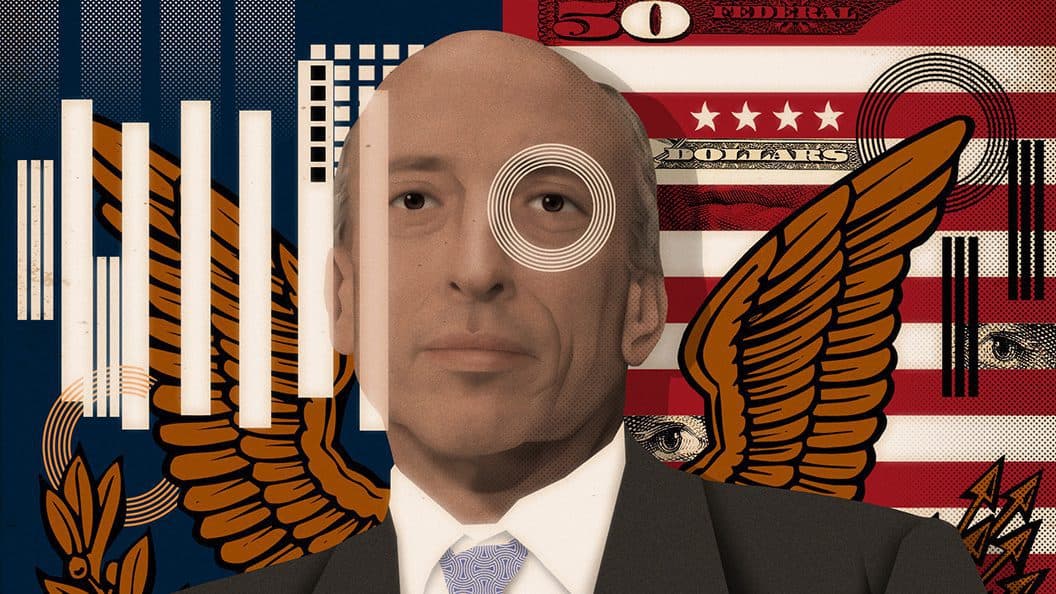One Year After SEC Lawsuit, Ripple CEO Says 2021 Was Their Best Year Yet
XRP is up almost 120% from the day prior to the SEC’s suit, despite many of the largest exchanges delisting the token

Gary Gensler, Chairman, SEC; Blockworks exclusive art by Axel Rangel
- Ripple CEO Brad Garlinghouse said on Twitter that Ripple’s on-demand liquidity have more than doubled since Q3 last year, despite a halt in the US
- Garlinghouse called the attack on Ripple an attack on crypto as a whole, and criticized the SEC’s policy of ‘strategic ambiguity’ towards digital assets
One year ago, then-SEC chair, Jay Clayton, used his last day in office to deliver a lump of coal to Ripple Labs, a company that he thought had been naughty, not nice.
The SEC, on one of the last business days before the Christmas holiday, announced it had charged Ripple Labs, CEO Brad Garlinghouse, and chairman Christian Larsen with conducting an unregistered securities offering.
The complaint was particularly scathing in its critique of Garlinghouse, noting, “While he was selling millions of XRP, Garlinghouse frequently told investors that he was invested in XRP, and that he was bullish on the investment.”
The SEC alleges that Garlinghouse and Larsen took in $600 million from sales of XRP, while being in control of Ripple, and therefore they are personally liable for the securities violations. The agency stopped short of alleging fraud — a more difficult charge to prove, according to Gabriel Shapiro, Partner at BSV Law, who described the case in-depth with his colleague Stephen Palley of Anderson Kill in an interview with Laura Shin.
 Brad Garlinghouse by Christopher Michel, CC BY 2.0, via Wikimedia Commons
Brad Garlinghouse by Christopher Michel, CC BY 2.0, via Wikimedia CommonsPredictably, XRP’s price crashed in the weeks after as many exchanges including Coinbase delisted the token. In January 2021, Ripple responded to the SEC’s allegations, calling the regulator “out of step” with global affairs and later “picking virtual currency winners and losers.”
But then something else happened. Despite being virtually walled off from the US, the rest of the world moved on and continued to embrace Ripple.
“Proud to say it was Ripple’s strongest year ever,” tweeted Ripple CEO Brad Garlinghouse recently, pointing out that the protocol’s On-Demand Liquidity network had seen a 130% increase in transactions quarter-over-quarter since Q3 2020 despite the US accounting for zero percent of it.
Garlinghouse said that some of the strongest growth was from entirely new payment corridors such as Japan and crypto-friendly United Arab Emirates.
Earlier this year, Ripple announced the launch of a white-label version of the XRP Ledger specifically designed for developing central bank digital currencies, to capitalize on increased interest in the currency type from central banks.
Wild West, or Tamed East?
As many countries such as the UAE and Singapore develop comprehensive digital asset frameworks to regulate the industry — and at the same time attract significant inbound investment — the US is maintaining a policy of “strategic ambiguity”, according to Garlinghouse, with regulators stuck with a view that crypto continues to be the ‘Wild West’ despite the east having figured out a way to regulate it.
“As Chair Gary Gensler seeks to expand its remit, he has taken an aggressively anti-crypto approach and companies are already moving outside the US. Web2 was built with many American companies, but Web3?” Garlinghouse tweeted.
“Ignoring its prior statements, the SEC today won’t answer questions about the legal status of ETH, much less anything else. Is the agency actually living up to its mission of protecting investors with regulation by enforcement and what Hester Peirce calls ‘strategic ambiguity’?”
Garlinghouse ended his Twitter thread by calling on his followers to write to their local Congressmen to ask them to take action on crypto legislation, “before the industry gets…another lump of coal.”
XRP is up almost 115% from the day prior to the SEC’s suit, according to CoinGecko, with around 17% of that happening in the past week. From a low at 17 cents on Dec. 29, it’s more than quintupled and is currently trading for 97 cents, down from a peak this year in April of $1.84.
This story was updated on December 23 at 12:05 pm ET to clarify the percentage change in the XRP price over the past year.
Get the day’s top crypto news and insights delivered to your inbox every evening. Subscribe to Blockworks’ free newsletter now.






